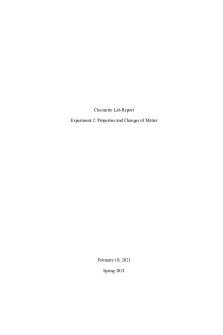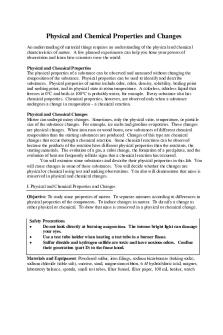03 Physical and Chemical Properties and Changes PDF

| Title | 03 Physical and Chemical Properties and Changes |
|---|---|
| Course | Chemistry Laboratory I |
| Institution | University of Miami |
| Pages | 6 |
| File Size | 107.3 KB |
| File Type | |
| Total Downloads | 16 |
| Total Views | 177 |
Summary
this covers all that was discussed in class...
Description
Physical and Chemical Properties and Changes An understanding of material things requires an understanding of the physical and chemical characteristics of matter. A few planned experiments can help you hone your powers of observation and learn how scientists view the world. Physical and Chemical Properties The physical properties of a substance can be observed and measured without changing the composition of the substance. Physical properties can be used to identify and describe substances. Physical properties of matter include odor, color, density, solubility, boiling point and melting point, and its physical state at room temperature. A colorless, odorless liquid that freezes at 0°C and boils at 100°C is probably water, for example. Every substance also has chemical properties. Chemical properties, however, are observed only when a substance undergoes a change in composition – a chemical reaction. Physical and Chemical Changes Matter can undergo many changes. Sometimes, only the physical state, temperature, or particle size of the substance changes. For example, ice melts and gasoline evaporates. These changes are physical changes. When iron rusts or wood burns, new substances of different chemical composition than the starting substances are produced. Changes of this type are chemical changes that occur through a chemical reaction. Some chemical reactions can be observed because the products of the reaction have different physical properties than the reactants, the starting materials. The evolution of a gas, a color change, the formation of a precipitate, and the evolution of heat are frequently telltale signs that a chemical reaction has occurred. You will examine some substances and describe their physical properties in this lab. You will cause changes in some of these substances. You will decide whether the changes are physical or chemical using test and making observations. You also will demonstrate that mass is conserved in physical and chemical changes. I. Physical and Chemical Properties and Changes Objective: To study some properties of matter. To separate mixtures according to differences in physical properties of the components. To induce changes in matter. To classify a change as either physical or chemical. To show that mass is conserved in a physical or chemical change. Safety Precautions Do not look directly at burning magnesium. The intense bright light can damage your eyes. Use a test tube holder when heating a test tube in a burner flame. Sulfur dioxide and hydrogen sulfide are toxic and have noxious odors. Confine their generation (part D) to the fume hood. Materials and Equipment: Powdered sulfur, iron filings, sodium bicarbonate (baking soda), sodium chloride (table salt), sucrose, sand, magnesium ribbon, 6 M hydrochloric acid, magnet, laboratory balance, spatula, small test tubes, filter funnel, filter paper, 100 mL beaker, watch
glass, evaporating dish, magnifying lens, crucible tongs, test tube rack, glass stirring rod, water bath (ring stand, ring clamp, wire gauze, burner, 250 mL beaker), and distilled water. Procedure A. The Physical Properties of Matter: Use clean spatulas to transfer to small, square pieces of clean paper a sample about the size of a pea of each of the following substances: powdered sulfur, iron filings, sodium bicarbonate, sodium chloride, sucrose, and sand. Place two individual pieces of magnesium ribbon 5 cm long on a paper. Write the name of each substance on its piece of paper. Examine each substance carefully. Test the effect of a magnet on each substance by passing the magnet under the paper of the sample. To avoid contamination, do not dip the magnet into the substances being tested. Test the solubility of each substance in water by adding a small amount of your sample about the size of a match head to about 3 mL of distilled water in a test tube. Stopper the test tube, and shake it briefly. Record your observations on the laboratory report. Procedure B. Causing a Physical Change: Combine the remaining samples of iron filings and sulfur on one piece of paper, and mix them thoroughly with a spatula. Examine the mixture with a magnifying glass, and move a magnet under the paper holding the mixture. Record your observations. Return this mixture to the bottle labeled ‘iron and sulfur mixture’ to be used in experiment 6, part D. Combine the salt and sand on one piece of paper, and mix thoroughly. Examine the mixture with a magnifying glass, and test the effect of a magnet. Record your observations. Transfer the salt-sand mixture to a clean 100 mL beaker, add about 30 mL of water, and stir with a glass rod for about 1 minute. Filter the mixture by gravity filtration, and collect the filtrate in a 100 mL beaker. Pour about 10 mL of the filtrate into a clean evaporating dish. Place the evaporating dish on a beaker of boiling water until the filtrate has evaporated to dryness. Remove the filter paper and its contents from the filter funnel. Examine the residue in the evaporating dish and the residue on the filter paper. Record your observations. Procedure C. Causing a Chemical Change: Grasp one end of a strip of magnesium ribbon with your crucible tongs, and hold it in a burner flame until it ignites. Caution: Do not look directly at the burning magnesium. Allow the combustion product to fall onto a clean watch glass. Do not dispose of the magnesium residue. Compare its appearance with that of the unburned strip of magnesium. Report your findings. Place the unburned strip of magnesium and the combustion product of the burned strip in separate, clean test tubes, and add 5 to 6 drops of 6 M hydrochloric acid to each. Record your observations. Transfer half the sucrose sample to a clean dry test tube, and heat it gently in a burner flame until it just starts to melt. Caution: Hold the test tube with a holder. Periodically check the odor at the mouth of the test tube by wafting the fumes toward you, and not any change in appearance of the sucrose. Look for a condensate (product of condensation) on the upper end of the test tube. Place the tube on wire gauze to cool. Scrape some of the residue out of the tube. Examine the residue, and test its water solubility. As a comparison, test the water solubility of the original sample of sucrose. Transfer the sodium bicarbonate sample to a clean dry test tube. Observe the system as you carefully add 5 drops of dilute hydrochloric acid to the sodium bicarbonate. Touch the bottom of the test tube to the palm of your hand. Record your observations.
Procedure D. Conservation of Mass: Transfer approximately equal quantities of the ‘iron filings and sulfur mixture’ kept from the previous experiment to two clean dry test tubes. Place one of the tubes in a test tube rack. Measure the mass of the other test tube and its contents accurately, and record the mass. Caution: The heating must be done only in a fume hood, and the test tube must be held with a holder. Heat the contents of this second tube in a burner flame. Heat it gently at first and then strongly for 1 to 2 minutes. Note any change in appearance that occurs. When the heating is complete, place the test tube on wire gauze to cool. When the test tube and its contents have cooled to room temperature, measure their mass and record the result. Use a spatula to scrape a sample of the iron filings and sulfur reaction product on a piece of clean dry paper. Break the sample into small pieces, and test with a magnet. Place the test tube and the remaining reaction product in the test tube rack beside the test tube containing the unreacted iron filings and sulfur mixture. Caution: Perform the following test in a fume hood. Add 5 to 6 drops of dilute hydrochloric acid to each tube. Carefully check the odor of any gas that is given off by wafting it cautiously toward you.
Laboratory Report for Physical and Chemical Properties and Changes Physical Properties of Matter
Substance
State Color Odor Solubility
Effect of Magnet
Sulfur Iron filings Sodium bicarbonate Sucrose Sand Sodium chloride Magnesium Causing a Physical Change Iron filings – sulfur mixture Appearance:
________________________________________________
Effect of a magnet:
________________________________________________
Salt – sand mixture: Appearance:
________________________________________________
Effect of a magnet:
________________________________________________
Residue in the evaporating dish (appearance):
______________________________
Residue on the filter paper (appearance):
______________________________
Causing a Chemical Change Magnesium strip Appearance:
__________________________________________
Combustion product (appearance):
__________________________________________
Action of 6 M hydrochloric acid on: Magnesium strip: __________________________________________ Combustion product:
__________________________________________
Action of heat on sucrose Change in appearance:
________________________________________________
Odor:
________________________________________________
Condensate on test tube:
________________________________________________
Solubility of sucrose:
________________________________________________
Solubility of residue:
________________________________________________
Action of 6 M hydrochloric acid on sodium bicarbonate: ______________________________________________________________________________ ______________________________________________________________________________ Conservation of Mass Mass of test tube and iron filings – sulfur mixture before heating: ______ Mass of test tube and iron-filings – sulfur mixture after heating: Mass difference:
______
______
Describe what you observed when the iron filings – sulfur mixture was heated: ________________________________________________________________________ ________________________________________________________________________ Effect of magnet on the reaction product:
____________________________________
Addition of HCl to unheated mixture (odor): ____________________________________ Addition of HCl to reaction product (odor): ____________________________________
Postlaboratory Questions 1. Did a chemical change occur when iron filings and sulfur were mixed? What evidence was there to support your answer?
2. What type of change occurred when water was added to the salt – sand mixture?
3. How did the substance recovered from the salt – sand mixture compare with the substances used in making the mixture?
4. What was the residue left after sucrose was heated?
5. Did iron filings and sulfur change chemically during the heating process? What evidence do you have to support your answer?
6. Is the reaction of sodium bicarbonate with hydrochloric acid endothermic or exothermic?
7. What is the name of the gas produced in the reaction between sodium bicarbonate and hydrochloric acid?...
Similar Free PDFs

Physical and Chemical Changes
- 2 Pages

Exploring Chemical Physical Changes
- 10 Pages

Properties and Changes of Matter
- 18 Pages

Bitesize Notes - Chemical Changes
- 57 Pages
Popular Institutions
- Tinajero National High School - Annex
- Politeknik Caltex Riau
- Yokohama City University
- SGT University
- University of Al-Qadisiyah
- Divine Word College of Vigan
- Techniek College Rotterdam
- Universidade de Santiago
- Universiti Teknologi MARA Cawangan Johor Kampus Pasir Gudang
- Poltekkes Kemenkes Yogyakarta
- Baguio City National High School
- Colegio san marcos
- preparatoria uno
- Centro de Bachillerato Tecnológico Industrial y de Servicios No. 107
- Dalian Maritime University
- Quang Trung Secondary School
- Colegio Tecnológico en Informática
- Corporación Regional de Educación Superior
- Grupo CEDVA
- Dar Al Uloom University
- Centro de Estudios Preuniversitarios de la Universidad Nacional de Ingeniería
- 上智大学
- Aakash International School, Nuna Majara
- San Felipe Neri Catholic School
- Kang Chiao International School - New Taipei City
- Misamis Occidental National High School
- Institución Educativa Escuela Normal Juan Ladrilleros
- Kolehiyo ng Pantukan
- Batanes State College
- Instituto Continental
- Sekolah Menengah Kejuruan Kesehatan Kaltara (Tarakan)
- Colegio de La Inmaculada Concepcion - Cebu











